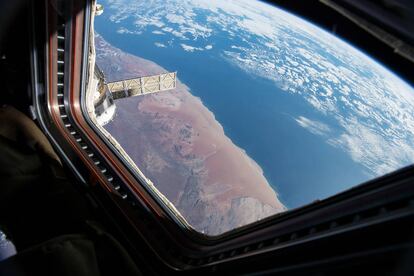25 years of the International Space Station: What next for a ‘beacon of peaceful international scientific collaboration’
Russia’s tensions with the U.S. and Europe make it difficult to reach an agreement on the end of the largest international cooperation project in space, which will remain operational at least until 2030

The International Space Station (ISS) turns 25 today, November 20, amid some safety concerns about its current operational capability and many doubts about its future, which NASA does not envision lasting beyond 2030. A quarter of a century of international cooperation in space led by two superpowers — the U.S. and Russia — who rival each other on Earth, is an unprecedented success in the history of mankind; but the ISS’ silver anniversary is being overshadowed by recent failures, such as the recurrent leaks of toxic gases in the radiators of one of the Russian modules.
On October 9, flakes of frozen ammonia, which is used as a coolant, were detected emanating from an external radiator on the Nauka module. NASA stated a few hours later in a communiqué that despite this highly toxic emanation “the station crew was never in danger” and, two weeks later, Russians Oleg Kononenko and Nikolai Chub managed to isolate the leak during a spacewalk. In addition to these two cosmonauts, two American women, a Japanese astronaut, another Russian and, at the head of the crew, the Danish commander Andreas Mogensen are currently living on the ISS. A total of seven astronauts, who make up the so-called Expedition 70.
The leaking radiator was transferred last April from another of the station’s modules and the issue follows two similar incidents in recent months, which the Russian space agency Roscosmos blamed on micrometeorite impacts. One of these affected a Soyuz spacecraft in December 2022 that was destined to carry back three cosmonauts, who were forced to remain in the ISS for a further six months. Normally, each crew member spends six months on the station.
Those radiators are the latest source of concern, following several air leaks in 2020 and a software failure in the Nauka module, which caused a tilt change of the entire space station upon docking with it in July 2021. Nauka is the latest section added to the ISS, construction of which began on November 20, 1998, when the first module, the Russian Zarya, was placed in orbit. Two weeks later, the U.S. Unity module was attached to it, and on November 2, 2000, the Expedition 1 crew arrived. Thus began an uninterrupted human presence on the station, which continues 23 years later.
The project is still ongoing despite the Russian invasion of Ukraine. In fact, it is one of the few lines of U.S.-Russian collaboration that remain open since then. International sanctions on Russia, stemming from that conflict, are a source of added tension with the U.S. and the other ISS partners — the European Space Agency (ESA) and those of Japan and Canada — making it difficult to plan for the future of the ISS.
However, a year before the start of the Ukrainian war, Russia had already indicated that it intended to withdraw from the ISS after 2025 because its operational lifespan had already expired and its condition left much to be desired. Initially conceived to be operational for 15 years, it will finally double its useful life if NASA’s plans are fulfilled, as it has secured funding to keep it in operation until 2030.

The challenge of de-orbiting the station
If that proves to be the case, the ISS will continue to be a huge international laboratory in orbit until the end of this decade, as NASA Administrator Bill Nelson emphasized in December 2021 when announcing the extension of the project: “The International Space Station is a beacon of peaceful international scientific collaboration and for more than 20 years has returned enormous scientific, educational, and technological developments to benefit humanity,” Nelson said. Moreover, Russia has not formally told its partners that it is leaving the project; on the contrary, it has indicated that it could continue until 2028 if the flight-sharing program succeeds, so that Russian cosmonauts can travel to the ISS on U.S. spacecraft (and U.S. astronauts on Russian rockets).
The endgame for the ISS will prove an unprecedented challenge, as did the station’s construction, which has made it the most expensive thing ever created by mankind. Due to its size — with a length of more than 100 meters and a weight of 94 tons — an uncontrolled deorbit has been ruled out, as is done with satellites and other minor space stations, for example, the US Skylab in 1978. NASA’s current plans call for an operation similar to the re-entry of the Russian Mir station in 2001. As on that occasion, the ISS will end up submerged in the Pacific Ocean, but with the added difficulty that it is four times larger. To safely bring the International Space Station back to Earth, a dedicated spacecraft will have to be built, the total cost of which is estimated at $1 billion over the course of this decade. NASA has so far only begun to sound out the U.S. aerospace industry for proposals to tackle this colossal project.
Even less clear is the plan for the eventual transition to private space stations, which the U.S. and Europe are working on. In fact, a NASA safety committee has just expressed concern about the timing and financial sustainability of the private projects, which are intended to produce and operate the several stations that will be needed to replace the ISS. “This transition requires a high-level framework and a very tight timeline. Of concern is the absence of a clear and robust business plan for commercial stations, which compromises the viability and security of NASA’s entire plan for low-Earth orbit,” said David West, a member of the NASA committee that met October 26.
Private space stations
NASA is funding the design of several private station projects, to be able to continue to keep its astronauts in orbit uninterruptedly. One of them is Orbital Reef, a joint initiative between Jeff Bezos’ Blue Origin and Sierra Space, which promise to have their station operational in 2027; however, both companies have had public disagreements and are giving priority to other space projects, without a team even contracted yet for Orbital Reef, which is intended to be a space business center. Rivaling that project is Starlab, an orbital research center that is scheduled to start operating in 2028 and has just been joined by the ESA.
Both projects aim to exploit the business opportunity presented by having factories and research laboratories in zero gravity. This is also the case of Axiom, another company that has even closer cooperation with NASA, which has created the spacesuit for astronauts on the upcoming Artemis missions to the Moon; in addition, in 2022, Axiom carried the first mission manned by private astronauts to the International Space Station, who stayed there for two weeks of space tourism. Axiom plans to add four modules to the ISS, starting in 2026. Later, those modules will be undocked from the station before it is sent to sink in the Pacific and begin operating as an independent space station.
However, there may be some extra life in the ISS yet. At a symposium held on November 2, Ken Bowersox, NASA’s associate administrator for space operations, said: “It’s not mandatory that we stop flying the ISS in 2030. But, it is our full intention to switch to new platforms when they’re available.” This is yet another indication that NASA does not see the projects to relieve the ISS as sufficiently advanced.
NASA is also contemplating the possibility that its de-orbit vehicle may not be ready until 2035. While the U.S. space agency’s plans to de-orbit the ISS have just been finalized, other proposals are emerging. At the end of Bowersox’s speech, a space policy expert suggested the opposite idea: raising the International Space Station to a stable orbit at the end of its useful life, so that it would remain a monument to space cooperation, visible from Earth as a faint artificial star.
Sign up for our weekly newsletter to get more English-language news coverage from EL PAÍS USA Edition
Tu suscripción se está usando en otro dispositivo
¿Quieres añadir otro usuario a tu suscripción?
Si continúas leyendo en este dispositivo, no se podrá leer en el otro.
FlechaTu suscripción se está usando en otro dispositivo y solo puedes acceder a EL PAÍS desde un dispositivo a la vez.
Si quieres compartir tu cuenta, cambia tu suscripción a la modalidad Premium, así podrás añadir otro usuario. Cada uno accederá con su propia cuenta de email, lo que os permitirá personalizar vuestra experiencia en EL PAÍS.
¿Tienes una suscripción de empresa? Accede aquí para contratar más cuentas.
En el caso de no saber quién está usando tu cuenta, te recomendamos cambiar tu contraseña aquí.
Si decides continuar compartiendo tu cuenta, este mensaje se mostrará en tu dispositivo y en el de la otra persona que está usando tu cuenta de forma indefinida, afectando a tu experiencia de lectura. Puedes consultar aquí los términos y condiciones de la suscripción digital.
More information
Archived In
Últimas noticias
Most viewed
- Sinaloa Cartel war is taking its toll on Los Chapitos
- Oona Chaplin: ‘I told James Cameron that I was living in a treehouse and starting a permaculture project with a friend’
- Reinhard Genzel, Nobel laureate in physics: ‘One-minute videos will never give you the truth’
- Why the price of coffee has skyrocketed: from Brazilian plantations to specialty coffee houses
- Silver prices are going crazy: This is what’s fueling the rally











































